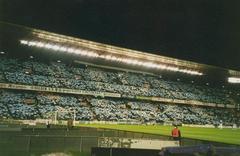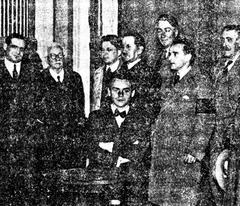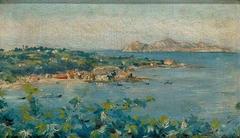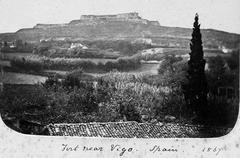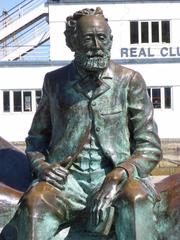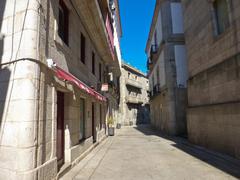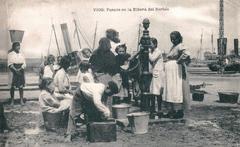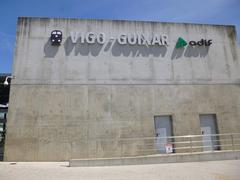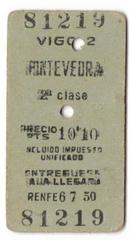Santiago De Vigo Church: Visiting Hours, Tickets, and Historical Sites in Vigo, Spain
Date: 04/07/2025
Introduction
In the heart of Vigo’s historic Casco Vello, the Santiago de Vigo Church—also known as “La Colegiata” or the Church of Santiago de Vigo—rises as a powerful symbol of the city’s enduring spiritual, cultural, and architectural heritage. Originating in the 12th century, this church has witnessed Vigo’s transformation from a modest fishing village to Galicia’s largest urban center. Dedicated to Saint James (Santiago), it has long served as both a vibrant parish and a vital stop for pilgrims journeying along the Camino de Santiago. The church’s unique architectural evolution seamlessly blends Neoclassical symmetry with Neo-Gothic embellishments, reflecting centuries of resilience through invasions, urban changes, and religious traditions (turismodevigo.org; vigoenfotos.com; nomads-travel-guide.com).
This comprehensive guide explores Santiago de Vigo Church’s historical development, architectural highlights, cultural significance, and practical visitor information, including current visiting hours, accessibility, guided tours, nearby attractions, and helpful travel tips. Whether you are a history enthusiast, an architecture lover, a pilgrim, or a curious traveler, this article will help you fully appreciate the enduring role of Santiago de Vigo Church in Vigo’s urban and spiritual landscape.
Historical Background
Origins and Early Development
Santiago de Vigo Church traces its roots to the early Middle Ages, with documented references dating from the 12th century, a period marking Vigo’s initial growth as a coastal settlement (turismodevigo.org). The dedication to Saint James underscores the church’s deep connection to the region’s Christianization and the wider Camino de Santiago pilgrimage network. The original building, likely Romanesque in style, featured robust stonework and minimal ornamentation, characteristic of rural Galician churches.
Destruction and Rebuilding
Over the centuries, the church suffered repeated adversities—pirate raids, military occupations, and urban encroachment. In 1589, Sir Francis Drake’s attack left much of the church and town destroyed. Subsequent reconstructions responded to community needs and the city’s evolving identity. By the 19th century, the medieval church had deteriorated and was further damaged during the Peninsular War, prompting a new Neoclassical construction completed in 1836 (nomads-travel-guide.com).
Architectural Evolution
Neoclassical Transformation
The rebuilt church, finished in 1836, exemplifies Galician Neoclassical architecture. The balanced façade, twin bell towers, and triangular pediment over the main entrance display classical symmetry and restraint. Local granite ties the structure visually to the city, while the sober design reflects the era’s preference for order and rationality (turismodevigo.org).
Neo-Gothic Enhancements
Subsequent modifications in the late 19th and early 20th centuries introduced Neo-Gothic elements, particularly to the façade, as directed by architect Manuel Felipe Quintana. Pointed arches, vertical lines, and decorative tracery evoke the medieval Gothic style, albeit with modest towers due to budget constraints (hoxe.vigo.org; vigoenfotos.com).
Interior Layout and Features
The church’s Latin cross plan comprises a spacious nave, side aisles, and a transept. Whitewashed walls and high vaulted ceilings create an atmosphere of tranquility and luminosity. The main altar, dedicated to Saint James, and various side chapels host devotional images and works by notable local artists, such as sculptor Francisco Asorey (explorial.com).
Materials and Construction
Constructed predominantly from local granite and finely carved wood, the church’s structure is both durable and visually harmonious with Vigo’s historic core. Stained glass windows and rose windows illuminate the interior with colored light, enhancing the space’s spiritual ambiance (vigoenfotos.com).
Artistic and Symbolic Elements
- Façade Sculptures: Statues symbolizing Faith, Hope, and Charity, plus biblical reliefs such as the Expulsion from Paradise and the Crucifixion.
- Main Altar: A polychrome woodcarving by Francisco Asorey, depicting scenes from the life of Christ.
- Stained Glass & Lighting: Pointed-arch and trilobed rose windows provide dynamic illumination throughout the day.
Cultural and Urban Significance
Civic Landmark and Community Hub
Santiago de Vigo Church anchors the Plaza de la Constitución, its bells marking the daily rhythms of city life. The church’s collegiate status since the 19th century elevates its religious and civic importance. It serves as a gathering place during festivals like Semana Santa and the feast of Saint James (July 25th), when processions, music, and communal events fill Vigo’s Old Town (onlybyland.com; nomads-travel-guide.com).
Integration with Urban Growth
As Vigo expanded, the church adapted to the changing urban fabric. The Casco Vello’s narrow streets and pedestrian plazas now surround the church, connecting it to the pulse of modern city life while preserving a tangible link to the past.
Religious and Social Role
Patronage of St. James and Pilgrimage
The church is a key spiritual waypoint for pilgrims on the Portuguese Coastal Route of the Camino de Santiago, offering blessings and the traditional “sello” (pilgrim’s stamp) (Danas Vistas). Major feasts and processions, especially on July 25th, showcase the church’s ongoing relevance to Galician religious life.
Community Services and Outreach
The church is integral to local parish life, providing sacraments, catechesis, and social support. Charitable initiatives include food drives and assistance for vulnerable groups, reflecting a commitment to solidarity and compassion.
Visiting Santiago de Vigo Church
Location
- Address: Praza Igrexa, 10, 36202 Vigo, Spain
- Neighborhood: Casco Vello (Old Town), easily walkable from city landmarks and public transport (ScopeTrip)
Visiting Hours
- Monday–Saturday: 9:00 AM – 7:00 PM
- Sundays & Holidays: 10:00 AM – 1:00 PM, 5:00 PM – 7:00 PM
- Note: Hours may vary during festivals and special events. Always check the official Vigo tourism website before your visit.
Tickets and Admission
- Entry: Free (donations appreciated)
- Guided Tours: Occasionally available through local tourism offices; inquire in advance for schedules
Accessibility
- Ramps at main entrance and accessible restrooms
- Some historic areas (e.g., choir loft) may have limited access for wheelchair users
Visitor Etiquette
- Modest attire is required (shoulders and knees covered)
- Maintain silence, especially during services; mobile phones off
- Photography permitted (no flash), except during Mass or in restricted areas
Travel Tips
- Arrive early for a quieter experience and best light for photography
- Spanish and Galician are spoken; a translation app can assist
- Public transport is recommended; parking is limited in Casco Vello
Nearby Attractions
- Co-Cathedral of Santa María (La Colegiata): Noted for its neoclassical style and the Cristo de la Victoria sculpture (SpottingHistory)
- Castro Fortress
- Praza da Constitución
- Museum of Contemporary Art (MARCO)
- Port area: Convenient for cruise passengers and ferry arrivals (DiscoveringVigo)
Rituals, Festivals, and Local Customs
- Feast of St. James (July 25th): Major celebration with processions, Masses, and cultural events
- Holy Week, Christmas, and Marian feasts: Distinctive rituals, music, and community gatherings
- Integration with Galician Traditions: Use of local music, costumes, and languages in church events
Frequently Asked Questions (FAQ)
Q: What are the visiting hours?
A: Monday–Saturday: 9:00 AM–7:00 PM. Sundays/Holidays: 10:00 AM–1:00 PM and 5:00 PM–7:00 PM.
Q: Is there an entry fee?
A: No, entry is free. Donations are welcomed.
Q: Are guided tours available?
A: Occasionally, via local tourism offices or by contacting the parish.
Q: Is the church accessible?
A: Yes, with ramps and accessible restrooms, though some historic areas may be limited.
Q: Can I take photographs?
A: Yes, but avoid flash and be respectful during services.
Q: Can pilgrims get their Camino de Santiago stamps here?
A: Yes, the church provides the traditional “sello” for pilgrims.
Visual Gallery
Related Articles
- Top Historical Sites to Visit in Vigo
- Exploring Galician Neoclassical Architecture
- Guide to the Camino de Santiago Pilgrimage
Conclusion
Santiago de Vigo Church stands as a beacon of architectural beauty, spiritual depth, and cultural vitality within Vigo. Its layered history, artistic treasures, and active parish life offer visitors an authentic and multifaceted experience. Whether you seek quiet reflection, artistic inspiration, or a deeper connection to Galician traditions, Santiago de Vigo Church is an essential highlight of any visit to Vigo.
For up-to-date information, download the Audiala app, follow us on social media, and consult official tourism resources for the latest on events, guided tours, and visitor tips.
References
- Santiago De Vigo Church: Visiting Hours, Tickets, and History of Vigo’s Iconic Historical Site, 2025, Turismo de Vigo (turismodevigo.org)
- Santiago de Vigo Church: Architectural Marvel and Visitor’s Guide to Vigo’s Historic Gem, 2025, Hoxe Vigo & Vigo en Fotos (hoxe.vigo.org), (vigoenfotos.com)
- Santiago de Vigo Church: History, Visiting Hours, Tickets & Cultural Significance in Vigo, 2025, Vigo en Fotos & Danas Vistas (vigoenfotos.com), (danasvistas.com)
- Santiago de Vigo Church Visiting Hours, Tickets & Guide to Vigo Historical Sites, 2025, ScopeTrip & SpottingHistory (scopetrip.com), (spottinghistory.com)
